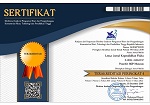PENGARUH MODEL PEMBELAJARAN QUANTUM TEACHING TIPE TANDUR TERHADAP KEMAMPUAN BERPIKIR KREATIF SISWA
DOI:
https://doi.org/10.33394/j-lkf.v3i2.382Keywords:
The ability creative thinking, Quantum teaching type TANDUR.Abstract
This purpose of this reseach was to measure the effect of Quantum Teaching model of TANDUR toward creative thinking ability of student. This research was conducted in the class VIII SMPN 3 Madapangga. The population of this study was all students grade VIII, and got two class as sample were VIIIa and VIIIb. Students at VIIIa as experimental and VIIIb as control class. This research was experimental reseach with post test only control group design. This study using purposive sampling. The instrument in this research was test of creative thinking was formed essay test. Data analysis in this study using t-test. From the treatment was obtaimed creative thinking ability with tcalc = 1,71 ≥ ttab = 1,68. This the null Hypotesis (Ho) in push away and alternative Hypotesis (Ha) in acceptance. From data analysis can concluded that Quantum Teaching type TANDUR can increase the creative thinking ability of students at vibration items and wave.References
Fauziah. 2011. Analisis Kemampuan Guru Dalam Mengembangkan Keterampilan Berpikir Kreatif Siswa Sekolah Dasar Kelas V Pada Pembelajaran Ilmu Pengetahuan Alam. Edisi Khusus No. 2, Agustus 2011. ISSN 1412-565X.
Fitriani Eni dan Mulyani, H.R.A. Pengaruh Penggunaan Variasi Metode dan Model Pembelajaran Terhadap Hasil Belajar Fisika Siswa Kelas VIII SMPN 2 Margatiga Semester Genap TP 2013/2014. Jpf. Vol. 1. Maret 2015. P – ISSN: 2337 – 5973. e – ISSN 2442 – 4838.
Riyanto. Yatim. 2010. Paradigma Baru Pembelajaran. Jakarta, Kencana.
Perdata dan Handayani. Meningkatkan Aktivitas Dan Prestasi Belajar Siswa Melalui Penerapan Model Pembelajaran QT Dengan Kerangka Tandur Dalam Pembelajaran Bangun Segi Empat Pada Siswa Kelas VII C SMP Pancasila Canggu Tahun Pelajaran 2011/2012. Vol. 4, nomor 1, Januari 2014. ISSN 2087 – 9016.
Rochmad, dkk. Kemampuan Berpikir Kreatif Siswa Pada Implementasi Project – Based Learning Dengan Peer and Self – Assessment Untuk Materi Segi Empat Kelas VII SMPN RSBI 1 Juwana di Kabupaten Pati. Proseding ISBN : 978 – 979 – 16353 : 8 – 7.
Downloads
Published
How to Cite
Issue
Section
License
Authors who publish with Lensa: Jurnal Kependidikan Fisika agree to the following terms:
- For all articles published in Lensa: Jurnal Kependidikan Fisika, copyright is retained by the authors. Authors give permission to the publisher to announce the work with conditions. When the manuscript is accepted for publication, the authors agree to automatic transfer of the publishing right to the publisher.
- Authors retain copyright and grant the journal right of first publication with the work simultaneously licensed under a Creative Commons Attribution-ShareAlike 4.0 International License that allows others to share the work with an acknowledgment of the work's authorship and initial publication in this journal.
- Authors are able to enter into separate, additional contractual arrangements for the non-exclusive distribution of the journal's published version of the work (e.g., post it to an institutional repository or publish it in a book), with an acknowledgment of its initial publication in this journal.
- Authors are permitted and encouraged to post their work online (e.g., in institutional repositories or on their website) prior to and during the submission process, as it can lead to productive exchanges, as well as earlier and greater citation of published work (See The Effect of Open Access).

This work is licensed under a Creative Commons Attribution-ShareAlike 4.0 International License.



